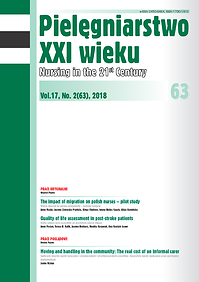Significance of music therapy in obstetrics and neonatology
DOI:
https://doi.org/10.2478/pielxxiw-2018-0016Keywords:
music therapy, music, obstetrics, neonatology, pregnancyAbstract
SIGNIFICANCE OF MUSIC THERAPY IN OBSTETRICS AND NEONATOLOGY
Introduction. The multi-faceted function of music and its influence on psychological as well as physical well-being have been known from ancient times. Positive reports regarding music therapy contributed to increased interest in this particular branch among many obstetricians and neonatologists. The following study describes the review of clinical trials concerning music influence on pregnant women, women giving birth and on newborns. It has been proved using cardiotocography that fetus reacts to music - for example increased fetal heart rate was monitored as well as the baby being more active when the mother was exposed to particular sounds.
Additionally, newborns respond positively (calm down more easily) when listening to the kind of music that their mothers had been listening to during pregnancy. Listening to classical, religious or even popular music can effectively reduce anxiety and pain sensation among pregnant women in both vaginal delivery as well as caesarean section. Two weeks of listening to music for 30 minutes a day can significantly reduce the risk of post-natal depression. In the case of newborns, especially premature neonates, the choice of music has a particularly strong impact. The American Academy of Pediatrics acknowledged 45 dB as an upper limit for the sound that should reach the incubator.
Results. Babies exposed to higher level of noise can be at risk of changes in routinely monitored parameters such as increased heart rate, breathing frequency and hypoxia. On the contrary, a reversed outcome can be achieved by applying pieces by Mozart. Current reports prove the positive influence of introducing music therapy as an element of interdisciplinary and holistic care of pregnant women and newborns.
References
1. Kędziora S. Znaczenie muzyki w okresie prenatalnym. Wartości w muzyce. 2012; 4: 288-299.
2. Galińska E. Muzykoterapia. [w:] Chodkowski A, red: Encyklopedia muzyki. Warszawa: PWN; 1995, s. 592-593.
3. Konieczna EJ. Arteterapia w teorii i praktyce. Kraków: Impuls; 2004, s. 42-43.
4. Chang MY, Chen CH, Huang KF, et al. Effects of Music Therapy on Psychological Health of Women during Pregnancy. Journal of Clinical Nursing. 2008; 17(19): 2580-2587.
5. García González J, Ventura Miranda M, Manchon García F, et.al. Effects of prenatal music stimulation on fetal cardiac state, newborn and vital signs of pregnant women: A randomized controlled trial. Complementary Therapies in Clinical Practice. 2017: 61-67.
6. Kierył M. Muzyka dla kobiet w ciąży. Muzykoterapia. https://maciejkieryl.wordpress.com/muzyka-dla-kobiet-w-ciazy/. Dostęp: 02.02.2018.
7. Bonna B. Muzyka w okresie prenatalnym. Zaangażowanie kobiet w ciąży we wspieranie rozwoju muzycznego dziecka. [w.] Bonna B, red: Historyczne i współczesne aspekty badań nad kulturą muzyczna i poezją. Bydgoszcz: Bydgoskie Towarzystwo Naukowe; 2012, s. 55-68.
8. Kończewska-Murdzek Z, Murdzek-Wierzbicka M. Rozwój dziecka w łonie matki. Problematyka płodności i prokreacji.www.stowarzyszeniefidesetratio.pl/Presentations0/2017-10Murdzek.pdf. [12.12.2017]
9. Granier-Deferre C, Bassereau S, Ribeiro A, et al. A Melodic Contour Repeatedly Experienced by Human Near-Term Fetuses Elicits a Profound Cardiac Reaction One Month after Birth. PLoS ONE. 2011; 6(2).
10. James DK, Spencer CJ, Stepsis BW. Fetal Learning: a Prospective Randomized Controlled Study. Ultrasound in Obstetrics and Gynecology. 2002; 20(5): 431-438.
11. Chang SC, Chen CH. Effects of Music Therapy on Women’s Physiologic Measures, Anxiety, and Satisfaction during Cesarean Delivery. Research in Nursing & Health. 2005; 28(6): 453-461.
12. Li Y, Dong Y. Preoperative Music Intervention for Patients Undergoing Cesarean Delivery. International Journal of Gynecology & Obstetrics. 2012; 119(1): 81-83.
13. Simavli S, Kaygusuz I, Gumus I, et al. Effect of Music Therapy during Vaginal Delivery on Postpartum Pain Relief and Mental Health. Journal of Affective Disorders. 2014; 156: 194-199.
14. Liu YH, Chang MY, Chen CH. Effects of Music Therapy on Labour Pain and Anxiety in Taiwanese First-Time Mothers. Journal of Clinical Nursing. 2010; 19(7-8): 1065-1072.
15. Simavli S, Gumus I, Kaygusuz I, et al. Effect of Music on Labor Pain Relief, Anxiety Level and Postpartum Analgesic Requirement: A Randomized Controlled Clinical Trial. Gynecologic and Obstetric Investigation. 2014; 78(4): 244-250.
16. Ebneshahidi A, Masood M. The Effect of Patient-Selected Music on Early Postoperative Pain, Anxiety, and Hemodynamic Profile in Cesarean Section Surgery. The Journal of Alternative and Complementary Medicine. 2008; 14(7): 827-831.
17. Reza N, Ali SM, Saeed K, et al. The Impact of Music on Postoperative Pain and Anxiety Following Cesarean Section. Middle East J Anaesthesiol. 2007; 19(3): 573-586.
18. Kushnir J, Friedman A, Ehrenfeld M, et al. Coping with Preoperative Anxiety in Cesarean Section: Physiological, Cognitive, and Emotional Effects of Listening to Favorite Music. Birth. 2012; 39(2):121-127.
19. American Academy of Pediatrics. Noise: A Hazard for the Fetus and Newborn. Pediatrics. 1997; 100: 724-726. http://pediatrics.aappublications.org/content/pediatrics/100/4/724.full.pdf [05.03.2018]
20. Swathi, S, Ramesh A, Nagapoornima M, et al. Sustaining a ‘Culture of Silence’ in the Neonatal Intensive Care Unit during Nonemergency Situations: A Grounded Theory on Ensuring Adherence to Behavioral Modification to Reduce Noise Levels. 2014. https://www.ncbi.nlm.nih.gov/pmc/articles/PMC3959455/. [03.01.2018].
21. Orosco H, Edwin P. Musicoterapia de Mozart y funciones vitales en la unidad de Neonatología del hospital regional del Cusco. Universidad Nacional de San Antionio Abad del Cusco. 2016. http://repositorio.unsaac.edu.pe/handle/UNSAAC/2549?show=full. [02.02.2018].
22. Yildiz A, Duygu A. The Effects of Giving Pacifiers to Premature Infants and Making Them Listen to Lullabies on Their Transition Period for Total Oral Feeding and Sucking Success. Journal of Clinical Nursing, Blackwell Publishing. 2011; 21(5-6): 644-656.
Published
Issue
Section
License
Copyright (c) 2018 Authors

This work is licensed under a Creative Commons Attribution-NonCommercial-NoDerivatives 3.0 Unported License.




